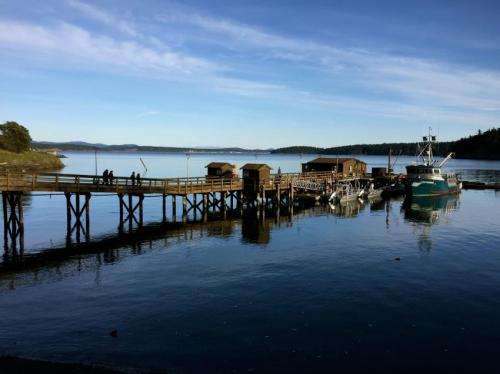Naturally acidic waters of Puget Sound surround UW's Friday Harbor Labs

For more than 100 years, marine biologists at Friday Harbor Laboratories have studied the ecology of everything from tiny marine plants to giant sea stars.
Now, as the oceans are undergoing a historic shift in chemistry, the lab is establishing itself as a place to study what that will mean for marine life. And the University of Washington laboratory is uniquely placed in naturally acidic waters that may be some of the first pushed over the edge by human-generated carbon emissions.
A paper published last month in Limnology and Oceanography tracks about two years of weekly pH data in Puget Sound, which have been collected since the UW established a facility there to study the effects of ocean acidification.
Researchers found typical values of dissolved carbon dioxide, or CO2, in Puget Sound are more than 650 parts per million, higher than even the 400 parts per million threshold that Earth's atmosphere crossed last year for the first time in modern humans' existence. In other words, Puget Sound's water is already higher in the gas than our CO2-choked atmosphere.
Measurements off the dock show that the water surrounding the lab has an average pH of about 7.8, which is acidic for seawater. Worldwide, average ocean pH is thought to have dropped from about 8.2 to 8.1 due to climate change.
"People have being going to Friday Harbor Labs to study the biology for 100 years, and they didn't really realize until we started doing these analyses that it would be a good place to try to study adaptation," said lead author James Murray, a professor in the UW School of Oceanography. "The CO2 levels have been high for a long time, so everything that lives up there must be extremely well adapted."
Increased carbon dioxide from burning fossil fuels can be blamed for 13 to 22 percent of the unusual acidity in Puget Sound, the new paper concludes. The rest is because of ocean currents that have made our waters naturally rich in nutrients, low in oxygen, and low in pH since long before the era of climate change.
The Friday Harbor Labs' Ocean Acidification Environmental Laboratory was established in 2011 and includes facilities where undergraduates, graduate students and researchers from the UW and elsewhere can monitor pH levels and mimic future changes in ocean chemistry.
Murray, a chemical oceanographer, did calculations to trace the origin of water properties measured at the facility. He found that most water in the Sound is from the California Undercurrent, a subsurface current that originates below a productive fishing area off the coast of Mexico and brings water that is high in nutrients and CO2, but low in oxygen and pH, north along the coast. When winds blow from the north off Washington's coast, the water near the surface gets blown offshore, and this deeper water gushes up and into Puget Sound.
Murray looked at different dates for when components of that water were last at the surface - 25 years ago, 50 years ago or 100 years ago - and what atmospheric CO2 would have been at that time. Those helped give the 13 to 22 percent range for the fingerprint of human-driven acidification.
"This tells the story of ocean acidification in Puget Sound, where we have a complex set of processes making naturally acidic water even more so over time," Murray said.
The pH levels off Friday Harbor's dock spiked in May and June 2012. That was likely due to the third factor influencing ocean water acidity: a plankton bloom, when tiny marine plants' photosynthesis used up CO2 and shifted the water toward higher, or more normal, pH.
Because pH is hard to measure and has only recently become a concern, little is known about the historic values, Murray said.
The UW is also working in a separate project with the National Oceanic and Atmospheric Administration to do real-time ocean acidification monitoring along the entire West Coast and its protected bays. Those observations show that the low values in Puget Sound are widespread, and provide more detail about the seasonal and spatial patterns that cause pH values here to dip and spike.
"This series of data from a location in the San Juan Islands helps us interpret the oceanographic processes that are responsible for conditions in our region," said Terrie Klinger, a UW professor of marine and environmental affairs and co-director of the UW-based Washington Ocean Acidification Center.
More information: Limnology and Oceanography, onlinelibrary.wiley.com/doi/10 … 2/lno.10062/abstract
Provided by University of Washington





















